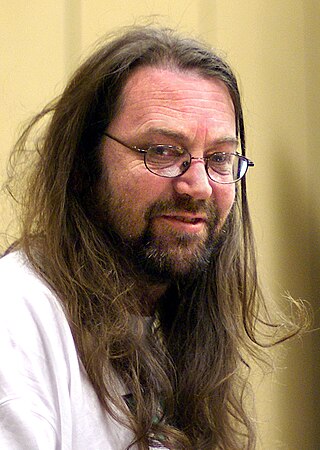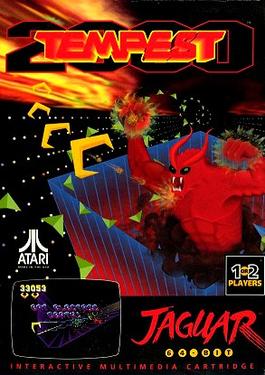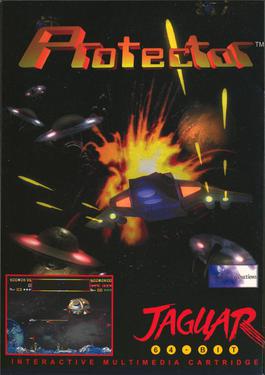
The Atari Jaguar is a home video game console developed by Atari Corporation and released in North America in November 1993. Part of the fifth generation of video game consoles, it competed with the 16-bit Sega Genesis, the Super NES and the 32-bit 3DO Interactive Multiplayer that launched the same year. Powered by two custom 32-bit processors – Tom and Jerry – in addition to a Motorola 68000, Atari marketed it as the world's first 64-bit game system, emphasizing its 64-bit bus used by the blitter. The Jaguar launched with Cybermorph as the pack-in game, which received divisive reviews. The system's library ultimately comprised only 50 licensed games.

Nuon is a technology developed by VM Labs that adds features to a DVD player. In addition to viewing DVDs, one can play 3D video games and use enhanced DVD navigational tools such as zoom and smooth scanning of DVD playback. One could also play CDs while the Nuon graphics processor generates synchronized graphics on the screen. There were plans to provide Internet access capability in the next generation of Nuon-equipped DVD players.

The 3DO Interactive Multiplayer, also referred to as simply 3DO, is a home video game console developed by The 3DO Company. Conceived by entrepreneur and Electronic Arts founder Trip Hawkins, the 3DO was not a console manufactured by the company itself, but a set of specifications, originally designed by Dave Needle and RJ Mical of New Technologies Group, that could be licensed by third parties. Panasonic produced the first models in 1993, and further renditions of the hardware were released afterwards by GoldStar, Sanyo, Creative Labs, and Samsung Electronics in 1997.

Jeff Minter is an English video game designer and programmer who often goes by the name Yak. He is the founder of software house Llamasoft and has created dozens of games during his career, which began in 1981 with games for the ZX80. Minter's games are shoot 'em ups which contain titular or in-game references demonstrating his fondness of ruminants. Many of his programs also feature something of a psychedelic element, as in some of the earliest "light synthesizer" programs including Trip-a-Tron.
John Mathieson is a British computer chip designer who initially worked for Sinclair Research on the cancelled Loki computer project before co-founding Flare with ex-Sinclair colleagues Martin Brennan and Ben Cheese.

Marble Madness is an arcade video game designed by Mark Cerny and published by Atari Games in 1984. It is a platform game in which the player must guide a marble through six courses, populated with obstacles and enemies, within a time limit. The player controls the marble by using a trackball. Marble Madness is known for using innovative game technologies: it was Atari's first to use the Atari System 1 hardware, the first to be programmed in the C programming language, and one of the first to use true stereo sound.

STMicroelectronics N.V. is a multinational corporation and technology company of French-Italian origin. It is headquartered in Plan-les-Ouates and listed on the New York Stock Exchange, on the Euronext Paris in Paris and on the Borsa Italiana in Milan. ST is the largest European semiconductor contract manufacturing and design company. The company resulted from the merger of two government-owned semiconductor companies in 1987: Thomson Semiconducteurs of France and SGS Microelettronica of Italy.

Fairchild Semiconductor International, Inc. was an American semiconductor company based in San Jose, California. It was founded in 1957 as a division of Fairchild Camera and Instrument by the "traitorous eight" who defected from Shockley Semiconductor Laboratory. It became a pioneer in the manufacturing of transistors and of integrated circuits. Schlumberger bought the firm in 1979 and sold it to National Semiconductor in 1987; Fairchild was spun off as an independent company again in 1997. In September 2016, Fairchild was acquired by ON Semiconductor.

Howard Scott Warshaw, also known as HSW, is an American psychotherapist and former game designer. He worked at Atari in the early 1980s, where he designed and programmed the Atari 2600 games Yars' Revenge, Raiders of the Lost Ark, and E.T. the Extra-Terrestrial.

Tempest is a 1981 arcade game by Atari Inc., designed and programmed by Dave Theurer. It takes place on a three-dimensional surface divided into lanes, sometimes as a closed tube, and viewed from one end. The player controls a claw-shaped "blaster" that sits on the edge of the surface, snapping from segment to segment as a rotary knob is turned.

Tempest 2000 is a tube shooter video game originally developed by Llamasoft and published by Atari Corporation for the Atari Jaguar in North America on 13 April, 1994. It was released in Europe on 27 June and in Japan on 15 December of the same year, with the Japanese release being published by Mumin Corporation. Part of Atari Corp.'s 2000 series, it is a remake by Jeff Minter of Dave Theurer's 1981 arcade game Tempest, which used Atari's QuadraScan vector color display technology.

Tempest 3000 is a remake of the 1981 Tempest arcade game released exclusively for the Nuon on December 12, 2000. Written by Jeff Minter, it is an enhanced version of Minter's own earlier Tempest 2000 (1994) for the Atari Jaguar. By 2003, the game had sold over 20,000 copies.
The Virtual Light Machine (VLM) is a light synthesizer developed by Jeff Minter in 1990. It was installed into a number of electronics, including the Atari Jaguar CD and Nuon DVD players.
In electronics engineering, video processing is a particular case of signal processing, in particular image processing, which often employs video filters and where the input and output signals are video files or video streams. Video processing techniques are used in television sets, VCRs, DVDs, video codecs, video players, video scalers and other devices. For example—commonly only design and video processing is different in TV sets of different manufactures.

Freefall 3050 A.D. is an action video game developed by Total ArKade Software and published in 2000 by VM Labs for the Nuon. It was one of only eight games officially released for the Nuon. The title was ported to Microsoft Windows in January 2019, and a cancelled port for the Xbox was unofficially released as open source in August 2019.

Protector is a horizontally scrolling shooter developed by Bethesda Softworks and published by Songbird Productions for the Atari Jaguar on November 27, 1999. It is based on Søren Grønbech's 1989 Amiga game Datastorm, which in turn it was inspired by both Defender and Dropzone.

Iron Soldier 3 is an open world first-person mecha simulation video game developed by Eclipse Software Design and originally published by Vatical Entertainment for the PlayStation on 20 June 2000 and was ported to the Nuon in 2001. A sequel to Iron Soldier 2, it is the third and last installment of the Iron Soldier series.













